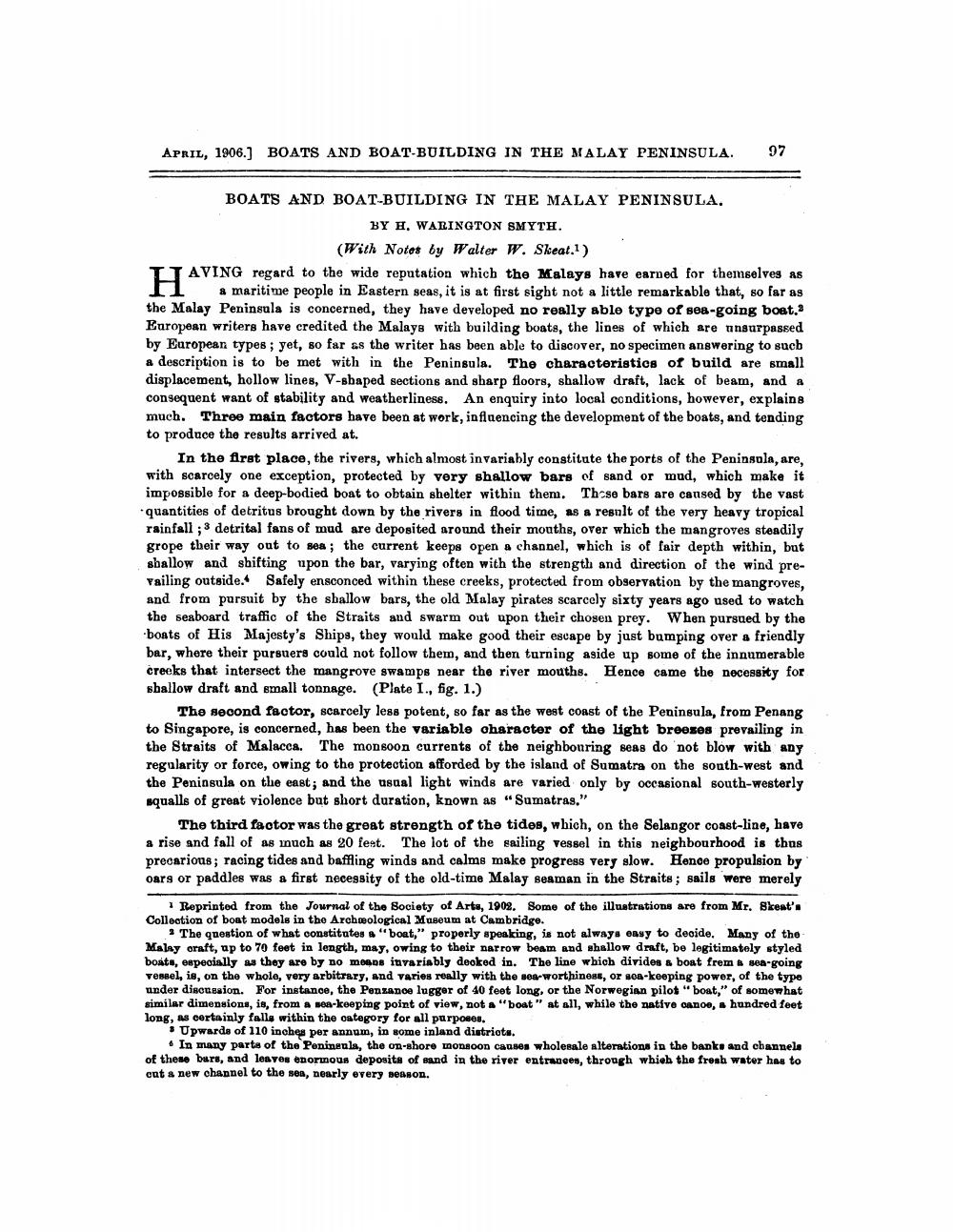________________
APRIL, 1906.) BOATS AND BOAT-BUILDING IN THE MALAY PENINSULA.
97
BOATS AND BOAT-BUILDING IN THE MALAY PENINSULA.
BY H, WALINGTON SMYTH.
(With Notes by Walter W. Skeat.) AVING regard to the wide reputation which the Malays have earned for themselves as
& maritime people in Eastern seas, it is at first sight not a little remarkable that, so far as the Malay Peninsula is concerned, they have developed no really able type of 898-going boat. European writers have credited the Malays with building boats, the lines of which are unsurpassed by European types; yet, so far as the writer has been able to discover, no specimen answering to sucb a description is to be met with in the Peninsula. The characteristics of build are small displacement, hollow lines, V-shaped sections and sharp floors, shallow draft, lack of beam, and a consequent want of stability and weatherliness. An enquiry into local conditions, however, explains much. Three main factors have been at work, influencing the development of the boats, and tending to produce the results arrived at.
In the first place, the rivers, which almost invariably constitute the ports of the Peninsula, are, with scarcely one exception, protected by very shallow bars of sand or mud, which make it impossible for a deep-bodied boat to obtain shelter within them. Those bars are caused by the vast quantities of detritus brought down by the rivers in flood time, as a result of the very heavy tropical rainfall ;detrital fans of mud are deposited around their mouths, over which the mangroves steadily grope their way out to sea; the current keeps open a channel, which is of fair depth within, but shallow and shifting upon the bar, varying often with the strength and direction of the wind preFailing outside. Safely ensconced within these creeks, protected from observation by the mangroves, and from pursuit by the shallow bars, the old Malay pirates scarcely sixty years ago used to watch the seaboard traffic of the Straits and swarm out upon their chosen prey. When pursued by the boats of His Majesty's Ships, they would make good their escape by just bumping over a friendly bar, where their pursuers could not follow them, and then turning aside up some of the innumerable creeks that intersect the mangrove swamps near the river mouths. Hence came the necessity for shallow draft and small tonnage. (Plate I., fig. 1.)
The second factor, scarcely less potent, so far as the west coast of the Peninsula, from Penang to Singapore, is concerned, has been the variable character of the light breezes prevailing in the Straits of Malacca. The monsoon currents of the neighbouring seas do not blow with any regularity or force, owing to the protection afforded by the island of Sumatra on the south-west and the Peninsula on the east; and the usual light winds are varied only by occasional south-westerly squalls of great violence but short duration, known as "Sumatras."
The third factor was the great strength of the tides, which, on the Selangor coast-line, have a rise and fall of as much as 20 feet. The lot of the sailing vessel in this neighbourhood is thus precarious; racing tides and baffling winds and calms make progress very slow. Hence propulsion by Oars or paddles was a first necessity of the old-time Malay seaman in the Straits ; sails were merely
Reprinted from the Journal of the Society of Arts, 1902. Some of the illustrations are from Mr. Skeat'. Collection of boat models in the Archeological Museum at Cambridge.
The question of what constitutes "boat," properly speaking, is not always easy to decide. Many of the Malay oraft, up to 70 feet in length, may, owing to their narrow beam and shallow draft, be legitimately styled boats, especially as they are by no means invariably deoked in. The line which divides & boat frem & sea-going vessel, is, on the whole, very arbitrary, and varies really with the sea-worthinese, or goa-keeping power, of the type under discussion. For instance, the Penzanoe lugger of 40 feet long, or the Norwegian pilot "boat," of somewhat similar dimensions, is, from a Hea-keeping point of view, not a "boat" at all, while the native canoe, a hundred feet long, as certainly falls within the category for all purposes.
• Upwards of 110 inches per annum, in some inland districts.
In many parts of the Peninsula, the on-shore monsoon causes wholesale alterations in the banks and channels of these bars, and leaves enormous deposits of sand in the river entrances, through which the fresh water has to cut & new channel to the sea, nearly every season.




